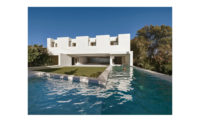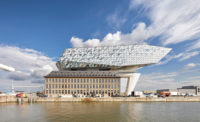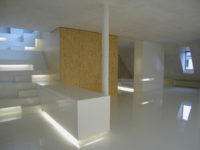Regardless of the city, historic protection for a particular district typically restricts exterior alterations but allows much more freedom within buildings. This often results in a standard sleek-modern interior of the kind beloved by real-estate agents. Not so for the renovation of the Z22 House in Zurich. Architect Gus Wüstemann, a Zurich native who also runs a studio in Barcelona, has taken a thoroughly subversive approach to a 170-year-old, three-story house. What’s the most radical and at the same time most conservative thing he could do? His answer: strip the building’s interiors right back to their original structure and leave them as far as possible like that.
On the exterior, this house in the Riesbach neighborhood, toward the southern edge of the city’s center, looks like many of the plainer mid-19th-century buildings in what is now an affluent district. Set a little way up the hillside overlooking the clear waters of Lake Zurich, nothing seems remarkable from the sidewalk: a pedimented neoclassical frontage, a white stucco facade, wood-framed windows, and a pitched roof. But when Wüstemann produces his bunch of keys and lets you in, you step into something that is a celebration of raw structure.
Additional Content:
Jump to credits & specifications
This is the “scrape-and-reveal” aesthetic taken to extremes. The moment when an old house is thoroughly gutted, just before all the usual new plastering and drywall and joinery and painting are done, before all the hard flooring and gleaming white porcelain plumbing fixtures arrive—that moment is what Wüstemann has chosen to freeze as his aesthetic and philosophy.
As we walk around the apartments, he is eloquent about this. “It’s all about values in architecture—working against the idea that the end result must look perfect,” he says. “It’s a kind of therapy: get rid of everything, strip everything right back to the core. Then you start to see who you are.”
The building was his client’s family home, though it is in fact a small complex. While the main house has its front door on the next street up the hill, its site included a row of industrial workshops down below on Feldegg street (the name translates as “field corner,” a remnant of the time when the area was a new suburb). They comprised a car paint shop and storage. Wüstemann has united the two zones by converting the workshops to small “atelier” apartments, bringing daylight in from above via skylights set into a new terrace that is shared by some of the living units in the main house. The only other significant external change is the addition of a new concrete balcony at second-floor level on the back of the old house.
Up to this point, it is a standard exercise: maximize rental returns by squeezing in the greatest number of apartments—five in the main house and four in the workshop zone below. What makes it very different are the interiors.
Wüstemann has worked hard to reveal and preserve the interior structure—which includes brick vaulting and recently added steel columns and beams in some of the former workshops, and, in the main house, rubblestone walls, and timber beams, floorboards, lintels, and attic rafters. He has done this throughout with seemingly unfinished surfaces: the original rough masonry and its lime mortar have been sprayed with a dust stabilizer that leaves no visible trace, while new sliding doors and partitions made of pine and (in the ateliers) oriented strand board (OSB) are treated with a clear lacquer.
OSB was also used as formwork to provide a textured finish on some of the cast-in-place concrete, such as on island kitchen counters. Concrete is one of the main new materials, for smooth floors (with radiant heating) and builtin benches in the ateliers. There Wüstemann has created what he calls a “topography” that defines the various areas for living, dining, and ablutions. Precast sinks and baths, fabricated off-site by a specialist manufacturer to achieve a smooth finish and precise dimensions, are found throughout.
Services risers (pipes, ducts, and conduits) are generally concealed behind double-walled polycarbonate, which also acts, via concealed luminaires, as a light source (most of the illumination is indirect, and the sources are LEDs or fluorescents). Wüstemann has also been ingenious in the way he has maximized usable space in what are fairly small apartments of some 540 square feet. Legally required enclosed storage, for instance, doubles as circulation, with shelves and space for hanging clothes hidden behind sliding doors on either side of a corridor. Thick pine kitchen worktop sections smoothly slide out to reveal cooking ranges below.
Because the old rubblestone walls of the house are over 3 feet thick and stucco-coated on the exterior, no internal or external insulation was required. New high-performance timber-framed triple-glazed units, with traditional vertically sliding exterior shutters, were simply inserted into the existing window apertures.
The “as found” feel runs from the most cavelike workshop apartment to the daylight-filled attic. It takes considerable skill and effort to convincingly pull off such an approach. But Wüstemann succeeds with brio. “It’s all very analog and organic,” he suggests. Not for everyone, perhaps, but tenants have bought into the lifestyle, with all the apartments rented.
CreditsArchitect: Gus Wüstemann Architects, www.guswustemann.com Neufrankengasse 18 8004 Zürich - CH Tel. +41 44 400 20 15 Escullera de Poble Nou 163, Port Olimpic 08005 Barcelona - ES Tel. +34 93 221 50 95
Personnel in architect's firm who should receive special credit: Manuel Greter, Bianca Kilian, Valentin Kokudev, Daniel Pelach, Panagiota Sarantinoudi, Gus Wüstemann
Engineers Engineer: Born Partner AG, www.bornpsrtner.ch HLSK Planer: Frei + Partner, www.frei-partner-ht.ch
General contractor: Gus Wüstemann Architects
Contractors: Builder: Corti AG, www.cortibau.ch Concrete Furniture: Dade Design, www.dade-design.com Carpenter (Flats): Ernst Wieland AG, www.wieland-ag.ch Carpenter (Ateliers): Gebert Möbelgestaltung, www.gebert-online.de Windows (wood): Huber Fenster, www.huberfenster.ch Frameless Sliding doors: Skyframe www.sky-frame.com Spengler: MARTI Komfortlüftung & Bauspenglerei AG, www.marti-kls.ch Skylights: Cupolux AG, www.cupolux.ch Heating: Kurtisi, www.kurtisi-ag.ch Sanitary: Heierli Partner Haustechnik AG, www.heierlipartner.ch Plasterer: Agosti AG, www.agosti.ch Metal: R+R Metallbau AG, www.rrmetallbau.ch Floors: Fiechter + Fuchs AG, www.fiechterfuchs.ch Carpenter: Cremer Bruhin AG, www.cremerbruhin.ch
Photographer: Bruno Helbling www.helblingfotografie.ch |
SpecificationsRoofing Tile/shingles: Roof Tiles: Cremer Bruhin AG, www.cremerbruhin.ch Other: MARTI Komfortlüftung & Bauspenglerei AG, www.marti-kls.ch
Windows Wood frame: Huber Fenster, www.huberfenster.ch Frameless Sliding doors: Skyframe https://www.sky-frame.com/
Glazing Glass: Huber Fenster, www.huberfenster.ch Skylights: Cupolux AG, www.cupolux.ch
Doors Sliding doors: OSB panels: Gebert Möbelgestaltung, www.gebert-online.de
Interior Finishes Special interior finishes unique to this project: Basic Raw Plaster
Furnishings Other furniture: Concrete Furniture: Dade Design, www.dade-design.com
Lighting Dimming system or other lighting controls: Spinaled Ribag, Melcom AG
|














Post a comment to this article
Report Abusive Comment